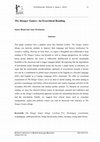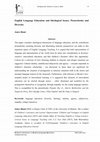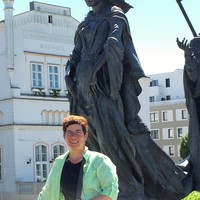Papers by Janice M . Bland

Using Literature in English Language Education. Challenging Reading for 8-18 Year Olds, 2018
One of the most attractive aspects of J. K. Rowling's Wizarding World for teenagers is its famili... more One of the most attractive aspects of J. K. Rowling's Wizarding World for teenagers is its familiarity. This still expanding storyworld is full of characters intimate and dear to huge numbers of readers and cinemagoers worldwide, particularly those who grew up alongside the heroes of the seven Harry Potter books. Studies have shown that the series has stayed with readers more than their other reading (Kozlowska 2014). Moreover many of the millennial generation of recently qualified teachers attest to the influence of Harry Potter on their well-being while at vulnerable stages in their lives. Doors are magically opened in both Harry Potter and the Cursed Child (Thorne 2016) and Fantastic Beasts and Where to Find Them, Original Screenplay (Rowling 2016); and metaphorically speaking, these hugely popular works can open doors to the world of literacy. They can support creativity and literacy development, including critical literacy, at a stage when young people may be deeply immersed and experienced in virtual worlds but still lack understanding of the real world. This lack is short term, but while it lasts it is a stumbling block for the adult canon – simplified versions of adult classics included. When teachers supply lacking background knowledge and 'model interpretations' to such classics, they have unwittingly chosen a simplistic solution, blocking opportunities for dialogic and deep reading. Finally, popular books such as these form a young adult canon, and offer an opportunity for bonding between teachers and their students.

Using Literature in English Language Education. Challenging Reading for 8-18 Year Olds, 2018
Dystopias have been a major part of the literary landscape for the best part of a century. Althou... more Dystopias have been a major part of the literary landscape for the best part of a century. Although classics such as Huxley's Brave New World (1932), Orwell's Nineteen Eighty-Four (1949) and Bradbury's Fahrenheit 451 (1953) were all first published well over sixty years ago, their relevance and urgency has not dimmed, so that they can be read alongside the plethora of more recent dystopias now demanding attention. The banning of books is a key element of despotic control in most dystopias, and yet, as Ray Bradbury himself urged in an interview with the New Seattle Times, 'You don't have to burn books to destroy a culture. Just get people to stop reading them' (Berson 1993: np). A concern among educators is ensuring that teenagers read and enjoy their core texts, the books they are expected to study, rather than employ avoidance strategies such as reading summaries and interpretations on the Web. Therefore the opportunities of the adult canon must wait, I argue, until teenagers have metamorphosed into readers – a step-by-step process that should begin well before the age of twelve while children are generally still excited by books. When reading in a foreign language, this slow but indispensable apprenticeship into literary literacy (learning to read the aesthetic nature of a literary text) is too often ignored by the curriculum.

This paper examines how a popular series like Suzanne Collins' The Hunger Games trilogy can motiv... more This paper examines how a popular series like Suzanne Collins' The Hunger Games trilogy can motivate students to improve their language and literacy proficiency by extensive reading. Moving on from there, we argue a thoughtful and collaborative deep reading of The Hunger Games can broaden as well as change perspectives; for without being openly didactic, the series is sufficiently multilayered to provide meaningful booktalk in the classroom and to trigger engaged debate. Recognising that the degradation of non-human nature through human action has become a major theme in education, we argue that the intentionally interdisciplinary approach of ecocriticism towards a literary text can be a contribution to global issues education in the English as a Second Language (ESL) and English as a Foreign Language (EFL) classroom. We offer an ecocritical examination of The Hunger Games, not as an ideal or model reading, but rather aiming to promote ecopedagogy and further critical discussion and creative language activities in the secondary ESL/EFL classroom and student teacher seminar. To illustrate an ecocritical reading, we trace the classical literary tropes of apocalypse, pastoral and wilderness and reflect on the trilogy's multilayered approach towards the relationship between the human and the non-human. Finally, we suggest how critical issues such as consumer manipulation, media and celebrity culture can well be discussed with reference to The Hunger Games trilogy.

This paper considers ideological dimensions of language education, and the contribution picturebo... more This paper considers ideological dimensions of language education, and the contribution picturebooks narrating diversity and illustrating minority perspectives can make to this important aspect of English Language Teaching. It is argued that both representation of language and representation of the world must be taken into consideration in diversity-sensitive, intercultural education, and that children's literature offers this opportunity. Criteria for a selection of texts featuring children in minority and refugee situations are suggested. Cultural identity, multifaceted subjectivity and agency – concepts important in children's literature scholarship – are discussed, as these ideas are significant for understanding the situation of protagonists in minority situations both in the stories and amongst language learners in the classroom. Furthermore, with reference to Byram's five-stranded model of intercultural learning, it is suggested that elements of intercultural education can be elicited through stories – either illustrated and modelled by the protagonists themselves or recognised, through empathy, by the young language learners.
Books by Janice M . Bland

The Institution of English Literature, 2017
In the EFL primary and secondary-school classroom there will be found a huge diversity of readers... more In the EFL primary and secondary-school classroom there will be found a huge diversity of readers and reading practices. Although most young students on entering secondary school will already have a sense of story, and functional literacy in their mother-tongue, they will also bring with them preferences for certain types of narrative such as adventure, school stories, fantasy, non-fiction and comics or graphic novels. Many children, however, develop an entrenched loss of interest in reading at about the age of 12. In Germany this is known as the Leseknick, and is sometimes called the Reading Blip in the English-speaking world. As the classroom is increasingly characterised by social and cultural diversity, it has become evident that a truly universal reading experience does not exist. In order to combat the Leseknick, therefore, the wide potential value of non-canonical literature should be demonstrated and explored in teacher education and exploited in the EFL classroom, including the rich opportunities for language and literary learning through graphic narratives and children’s literature.

Children’s literature can be a powerful way to encourage and empower ELT in primary and secondary... more Children’s literature can be a powerful way to encourage and empower ELT in primary and secondary school settings, but is less commonly used globally than simplified versions of adult literature. Children’s Literature and Learner Empowerment provides a comprehensive introduction to children's and young adult literature in language teaching. It demonstrates the complexity of children's literature and how it can encourage an active community of second language readers with multi-layered picturebooks, postmodern fairy tales, graphic novels and radical young adult fiction. It also examines the opportunities of children's literature in teacher education, including: children's literature for a pleasurable literary apprenticeship, the rich patterning of children's literature supporting creative writing, and the potential of children’s literature for intercultural communicative competence and critical literacy. Close readings of texts at the centre of contemporary literary scholarship, yet largely unknown in ELT, provide an invaluable guide for teacher educators and student teachers, including works by Anthony Browne, Philip Pullman and J.K.Rowling. This study makes an important new approach accessible for English teachers, student teachers and teacher educators.

Leading international scholars contributing to this volume examine the core issues of teaching En... more Leading international scholars contributing to this volume examine the core issues of teaching English as a foreign language to young learners. English as a discipline and as a teaching medium is expanding rapidly throughout the world, yet English for young learners receives far less attention to date from second language researchers and educational theorists than TESOL with secondary students or adults. The individual chapters cover the crucial issues critically and in-depth, not ignoring the problems in implementation, while searching to identify the advantages of English for young learners. Certain topics that have long been considered successful with young learners are examined, with reports on recent studies and literature reviews of the most relevant research into why these methods are favoured: CLIL, immersion teaching, task-based learning, oral storytelling, poetry and nursery rhymes, drama and booktalk with picturebooks. While some topics, although not new, are becoming more urgent: intercultural understanding, teaching with technology, understanding the role of formulaic language, materials development and assessment for example, other topics are rapidly emerging, such as English in pre-primary. The language development of young learners, although not the only aim of plurilingual education, is considered a central aim. The usage-based approach to language acquisition, which highlights children’s experience of language through engagement with input – how children’s lexical and grammatical knowledge can develop or emerge through oracy and literacy events – is a major theme.

This chapter describes how an early awareness of lexical patterns, grammatical categories and gra... more This chapter describes how an early awareness of lexical patterns, grammatical categories and grammatical judgements can be supported through an active engagement with poetry for children. Although acquired as unanalysed wholes in the primary school, formulaic sequences can provide young learners with an inventory of illustrative exemplars, which may later be recalled from memory. With sufficient input, the young learners may infer productive patterns, and increased command of language may gradually emerge. Thus poetry as pattern-rich, pleasurable language can also function as a template for the future. Language itself, second language acquisition and poetry all rely on repeated patterns. Children delight in these patterns, which support functional literacy. Mini narrative poems allow young learners to create mental models of the storyworld and mental representations of language. Poems can transmit cultural knowledge, can offer opportunities for humour in a motivating classroom environment, and can – like all literature – train flexibility of perspective.
Journal editing by Janice M . Bland
Children's Literature in English Language Education is a bi-annual, comprehensively peer-reviewed... more Children's Literature in English Language Education is a bi-annual, comprehensively peer-reviewed online journal for scholars, teacher educators and practitioners involved in using and researching children’s literature in the field of English learning as a second, additional or foreign language. The journal investigates children’s literature as an art form, and as a framework with which to connect L2 literature teaching across the school years. The scope covers the affordances of children’s literature for L2 acquisition with pre-school infants through to young adults. http://clelejournal.org/category/issues/volume-4-issue-1-may-2016/
Children's Literature in English Language Education, 2016
Children's Literature in English Language Education is a bi-annual, comprehensively peer-reviewed... more Children's Literature in English Language Education is a bi-annual, comprehensively peer-reviewed online journal for scholars, teacher educators and practitioners involved in using and researching children’s literature in the field of English learning as a second, additional or foreign language. The journal investigates children’s literature as an art form, and as a framework with which to connect L2 literature teaching across the school years. The scope covers the affordances of children’s literature for L2 acquisition with pre-school infants through to young adults.
http://clelejournal.org/category/issues/volume-4-issue-2-november-2016/
Children's Literature in English Language Education, 2017
Children's Literature in English Language Education is a bi-annual, comprehensively peer-reviewed... more Children's Literature in English Language Education is a bi-annual, comprehensively peer-reviewed online journal for scholars, teacher educators and practitioners involved in using and researching children’s literature in the field of English learning as a second, additional or foreign language. The journal investigates children’s literature as an art form, and as a framework with which to connect L2 literature teaching across the school years. The scope covers the affordances of children’s literature for L2 acquisition with pre-school infants through to young adults.
http://clelejournal.org/journal-profile/








Uploads
Papers by Janice M . Bland
Books by Janice M . Bland
Journal editing by Janice M . Bland
http://clelejournal.org/category/issues/volume-4-issue-2-november-2016/
http://clelejournal.org/journal-profile/
http://clelejournal.org/category/issues/volume-4-issue-2-november-2016/
http://clelejournal.org/journal-profile/